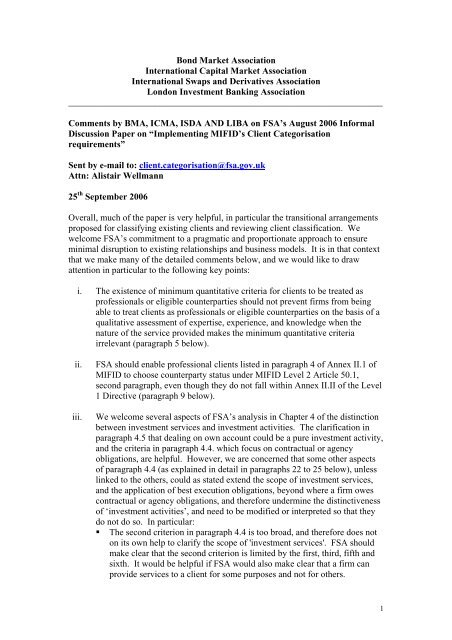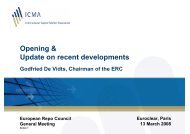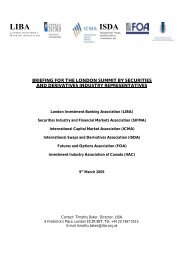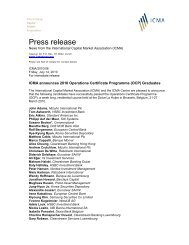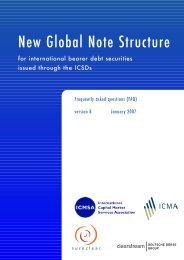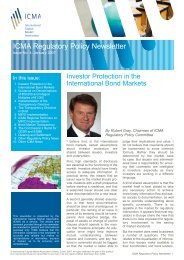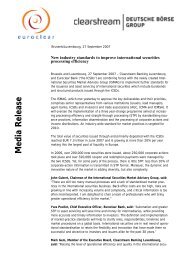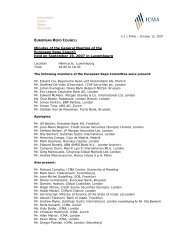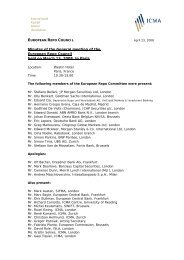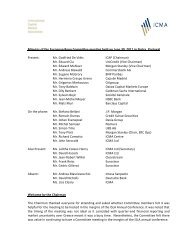MIFID Client Classification Response - ICMA
MIFID Client Classification Response - ICMA
MIFID Client Classification Response - ICMA
You also want an ePaper? Increase the reach of your titles
YUMPU automatically turns print PDFs into web optimized ePapers that Google loves.
Bond Market Association<br />
International Capital Market Association<br />
International Swaps and Derivatives Association<br />
London Investment Banking Association<br />
_____________________________________________________________________<br />
Comments by BMA, <strong>ICMA</strong>, ISDA AND LIBA on FSA’s August 2006 Informal<br />
Discussion Paper on “Implementing <strong>MIFID</strong>’s <strong>Client</strong> Categorisation<br />
requirements”<br />
Sent by e-mail to: client.categorisation@fsa.gov.uk<br />
Attn: Alistair Wellmann<br />
25 th September 2006<br />
Overall, much of the paper is very helpful, in particular the transitional arrangements<br />
proposed for classifying existing clients and reviewing client classification. We<br />
welcome FSA’s commitment to a pragmatic and proportionate approach to ensure<br />
minimal disruption to existing relationships and business models. It is in that context<br />
that we make many of the detailed comments below, and we would like to draw<br />
attention in particular to the following key points:<br />
i. The existence of minimum quantitative criteria for clients to be treated as<br />
professionals or eligible counterparties should not prevent firms from being<br />
able to treat clients as professionals or eligible counterparties on the basis of a<br />
qualitative assessment of expertise, experience, and knowledge when the<br />
nature of the service provided makes the minimum quantitative criteria<br />
irrelevant (paragraph 5 below).<br />
ii.<br />
iii.<br />
FSA should enable professional clients listed in paragraph 4 of Annex II.1 of<br />
<strong>MIFID</strong> to choose counterparty status under <strong>MIFID</strong> Level 2 Article 50.1,<br />
second paragraph, even though they do not fall within Annex II.II of the Level<br />
1 Directive (paragraph 9 below).<br />
We welcome several aspects of FSA’s analysis in Chapter 4 of the distinction<br />
between investment services and investment activities. The clarification in<br />
paragraph 4.5 that dealing on own account could be a pure investment activity,<br />
and the criteria in paragraph 4.4. which focus on contractual or agency<br />
obligations, are helpful. However, we are concerned that some other aspects<br />
of paragraph 4.4 (as explained in detail in paragraphs 22 to 25 below), unless<br />
linked to the others, could as stated extend the scope of investment services,<br />
and the application of best execution obligations, beyond where a firm owes<br />
contractual or agency obligations, and therefore undermine the distinctiveness<br />
of ‘investment activities’, and need to be modified or interpreted so that they<br />
do not do so. In particular:<br />
• The second criterion in paragraph 4.4 is too broad, and therefore does not<br />
on its own help to clarify the scope of 'investment services'. FSA should<br />
make clear that the second criterion is limited by the first, third, fifth and<br />
sixth. It would be helpful if FSA would also make clear that a firm can<br />
provide services to a client for some purposes and not for others.<br />
1
• In the case of the third criterion, an agreement that there is no client<br />
relationship should be conclusive in the case of professional clients, who<br />
by definition have the knowledge and expertise to determine whether or<br />
not they wish to transact on a service basis.<br />
• It is important that the fourth criterion is not taken as implying that a<br />
dealer would need to deal exclusively with eligible counterparties to avoid<br />
owing best execution obligations. Since the third criterion covers the<br />
expectations of the parties, we suggest that FSA should delete the fourth<br />
criterion.<br />
We urge FSA to ensure that the interpretation as a whole is consistent with<br />
<strong>MIFID</strong> Level 1 Recital 33, and that it is reflected in its interpretation of ‘client<br />
order’, along the lines which we set out in our response to DP06/3 (paragraphs<br />
19 to 25 below).<br />
iv.<br />
It will be important to explore the scope for interpreting the large undertaking<br />
thresholds flexibly so that members of large groups that happen on an<br />
individual company basis to fall below the size requirements are not prevented<br />
from being treated as professional clients (paragraph 31 below).<br />
Detailed comments<br />
Chapter 2<br />
1. It would be helpful if FSA confirmed how the quantitative tests for “large<br />
undertakings” apply to entities such as trusts. While trusts may not have<br />
“turnover” as such, it seems to us that the concept of “own funds” can be<br />
applied as if it referred to net assets. It will be important as far as possible to<br />
enable trusts which are currently intermediate customers to map across into<br />
the professional category.<br />
2. Paragraph 2.12. Footnote 19 is a helpful clarification of the meaning of<br />
bringing about or entering into transactions, and that the ECP regime embraces<br />
corporate finance advice as an ancillary service. In the latter context, it is<br />
important all aspects of corporate finance advice are embraced within ancillary<br />
services.<br />
3. Paragraph 2.14. We welcome the helpful clarification of flexibility to agree<br />
selective obligations for ECPs. FSA should confirm that the resulting<br />
obligations are contractual in nature (not regulatory obligations arising under<br />
FSA rules).<br />
4. Paragraph 2.16. We agree that firms have the choice whether to provide<br />
services to a client on the basis of a different categorisation that a client<br />
requests.<br />
5. Paragraphs 2.20 and 2.21. The quantitative criteria are based on a model of<br />
clients that enter into transactions and hold portfolios of financial instruments.<br />
FSA should adopt a purposive approach to the application of these quantitative<br />
criteria to services of a type to which the frequency of transactions and size of<br />
portfolio are not relevant, for example corporate finance. In cases where the<br />
2
minimum criteria are irrelevant because of the nature of the service, firms<br />
should simply be required to make a qualitative assessment of the expertise,<br />
experience, and knowledge of the client. (Cf FAQ10)<br />
6. FSA should clarify when charities are "undertakings" and thus can qualify as<br />
large undertakings. The definition in section 259 Companies Act 1985 is<br />
helpful in so far as it indicates that incorporated charities are to be regarded as<br />
undertakings. It also suggests that a partnership or an unincorporated<br />
association is an undertaking if it carries on a trade or business, with or<br />
without a view to profit.<br />
7. Paragraph 2.21. It would be helpful if FSA could clarify that it would be<br />
reasonable to interpret ‘working in the financial sector’ as including working<br />
in the relevant department of a corporate which was involved in the financial<br />
sector, even though the financial sector might not be the corporate’s primary<br />
business.<br />
8. We welcome FSA’s proposal in paragraph 2.26 to take full advantage of the<br />
Directive’s discretions to give clients the maximum flexibility to be treated as<br />
ECPs. FSA should apply the same approach to elective ECPs as to elective<br />
professionals in cases where the quantitative criteria are not applicable, as<br />
described in paragraph 5 above.<br />
9. Furthermore, in order to give clients maximum flexibility, FSA should also<br />
enable those professional clients listed in paragraph 4 of Section I of Annex II<br />
of <strong>MIFID</strong> to choose eligible counterparty status under <strong>MIFID</strong> Level 2 Article<br />
50.1, second paragraph. We consider that, in this context, the cross-reference<br />
in the second paragraph of article 50.1 to clients who are considered to be<br />
professional clients “in accordance with Section II of Annex II” <strong>MIFID</strong>,<br />
should be read as also covering persons falling within paragraph 4 of Section I<br />
of Annex II who could be treated as professionals in accordance with that<br />
section if it applied to them. It would create an unacceptable anomaly if, for<br />
example, firms could not treat smaller hedge funds as ECPs.<br />
10. In any event, the answer to FAQ 21 should be amended to bring it into line<br />
with paragraph 2.25 and Footnote 27 by referring to the possibility, under the<br />
second paragraph of Level 2 Directive Article 50.1, for elective professionals<br />
to choose ECP status.<br />
11. We welcome the flexibility of interpretation of quantitative thresholds that<br />
FSA points towards in paragraph 2.34, but we think that there should be much<br />
more latitude for clients to drop below thresholds for longer than one day<br />
without losing their elective status.<br />
12. We agree with FSA’s initial preference in paragraph 2.43 for the third option<br />
under paragraph 2.38. It is very important in this context to maximise the<br />
extent of grandfathering of existing classifications.<br />
13. We support the approach to client classification for non-<strong>MIFID</strong> business that<br />
FSA proposes in paragraph 2.47, to use <strong>MIFID</strong> nomenclature but modify the<br />
3
criteria, such as the disapplication of quantitative tests for opting up to<br />
professional status. However, FSA should also provide for disapplication of<br />
quantitative tests for <strong>MIFID</strong> business as described in paragraph 5 above.<br />
14. It would be helpful to have a discussion of the treatment of client classification<br />
issues in relation to branches of EEA firms in other EEA states. There are a<br />
number of practical issues which are of considerable importance, bearing in<br />
mind that the operations in the branch will be subject to home state rules for<br />
some purposes where client classification matters (e.g. in relation to client<br />
assets or any services the branch may provide which are not provided “within”<br />
the branch state) but subject to the branch state rules for other purposes (e.g. in<br />
relation to services provided within the branch state). If the home state rules<br />
are to apply for client classification purposes, it may be necessary or desirable<br />
for the home state to be able to “grandfather” classifications as a professional<br />
made in accordance with the rules of the branch state. It will also be necessary<br />
to address the treatment of eligible counterparties in the branch state under<br />
article 24.3 MiFID.<br />
Chapter 3<br />
15. We welcome FSA’s proposal in paragraph 3.10 to permit firms to make use of<br />
the transitional grandfathering provision in the penultimate paragraph of<br />
Annex II.II.2 to enable existing expert private customers to be categorised as<br />
professional clients under <strong>MIFID</strong>.<br />
16. We urge FSA to enable firms to make use of the transitional grandfathering<br />
provision in Level 1 Article 71.6, as described in paragraph 3.13. We very<br />
much support FSA’s preliminary view as set out in footnote 48. Efficient use<br />
of transitional grandfathering provisions will be very important for the smooth<br />
and cost-effective transfer to the <strong>MIFID</strong> regime.<br />
17. We think that FSA should enable firms to grandfather existing market<br />
counterparties as professional investors under Article 71.6. This confirmation<br />
will be important in relation to advice or portfolio management services,<br />
which fall outside <strong>MIFID</strong> Level 1 Article 24.1, for which clients will be<br />
professionals under <strong>MIFID</strong>, and in relation to any existing market<br />
counterparties who are not able to be treated as eligible counterparties under<br />
Article 24, for example because they do not meet size tests.<br />
18. FSA should also enable firms to take account of the fact that a client has<br />
previously been treated as professional by another firm when assessing the<br />
expertise, experience, and knowledge of the client.<br />
Chapter 4<br />
19. The analysis of the distinction between investment services and investment<br />
activities is in several respects a helpful clarification of how the best execution<br />
provisions might apply under <strong>MIFID</strong> (but seen also paragraph 21 below).<br />
However, it is important to consider all of the criteria together, because in<br />
certain respects some of them on their own suggest an interpretation which<br />
4
isks being both too broad and inconsistent with <strong>MIFID</strong> provisions on when<br />
best execution does or does not apply.<br />
20. In particular, the clarification in paragraph 4.5 that dealing on own account<br />
could be a pure investment activity, and the criteria in paragraph 4.4 which<br />
focus on contractual and agency obligations, are helpful. However, other parts<br />
of paragraph 4.4, if taken on their own, could as stated extend best execution<br />
obligations beyond where a firm owes contractual or agency obligations, and<br />
need to be modified or interpreted so that they do not do so. These points are<br />
amplified in paragraphs 22 to 25 below. The discussion of the exclusion of<br />
eligible counterparties in paragraph 4.10 is also helpful, although it must not<br />
be interpreted as implying that eligible counterparty status is the only<br />
circumstance in which a firm does not owe best execution obligations.<br />
21. FSA states in paragraph 4.14 that FSA will consider interpretative questions<br />
with respect to the definition of ‘client order’ “in the COB CP as part of our<br />
feedback on the [best execution] DP”. Since this interpretation is crucial to<br />
determining the scope of best execution provisions and therefore the potential<br />
impact on firms’ current business models and the scale of the system changes<br />
that firms may need to make, we urge FSA to build on paragraph 4.4 to<br />
confirm as early as possible an interpretation of ‘client order’ along the lines<br />
which we set out in our responses to DP06/3, and indicate whether this<br />
interpretation is shared by other EEA regulators.<br />
22. Turning to the detail of paragraph 4.4, the first, third, fifth and sixth criteria<br />
are broadly consistent with <strong>MIFID</strong> Level 1 Recital 33: “[the best execution<br />
obligation] should apply to the firm which owes contractual or agency<br />
obligations to the client”, and should therefore form the core of FSA’s analysis<br />
(but see also our comments on the third criterion below). The second and<br />
fourth criteria should be limited by reference to the others.<br />
23. The second criterion is too broad, and therefore does not on its own help to<br />
clarify the boundary between ‘investment services’ and ‘investment activities’<br />
or reflect the ability of the parties under the third criterion to agree that they<br />
transact on an activities basis. Commercial relationships often involve ‘some<br />
act or work for the other person’ in circumstances where the firm is not acting<br />
in a contractual or agency capacity on behalf of the other person, which is a<br />
crucial element of <strong>MIFID</strong> Level 1 Article 4.1(5)’s definition of ‘execution of<br />
orders on behalf of clients’. The criterion is so broad that it could mean that<br />
almost any act brings an ‘investment activity’ within the ‘investment service’<br />
category. For example, two OTC dealers in shares could agree to a transaction<br />
to enable one or the other to make a portfolio adjustment. They will need to<br />
agree which of them will publish a trade report. They may from time to time<br />
take it in turns. We presume it is not FSA’s intention that they should be<br />
clients of each other. FSA’s examples cover a range of circumstances in<br />
which a firm does not necessarily owe a contractual or agency obligation to<br />
act on the other person’s behalf. It is not the fact that a firm ‘works’ or<br />
‘customises’ a transaction that should determine whether or not a firm<br />
provides a service and owes best execution, but whether or not it does so with<br />
an agency obligation or undertakes contractually to act on the client’s behalf.<br />
5
Almost any transaction, including many that do not involve an investment<br />
service but are clearly an investment activity, may involve providing a ‘facility<br />
to the other person such as the facilitation of transactions or providing an<br />
opportunity to trade’. FSA should therefore make clear that the second<br />
criterion is limited by the first, third, fifth, and sixth. It would be helpful if<br />
FSA would also make clear that a firm can provide services to a client for<br />
some purposes and not for others.<br />
24. The third criterion is related to the first, and therefore an element of<br />
‘contractual and agency obligations’. We agree that a statement that there is<br />
no client relationship should not be conclusive so far as retail clients are<br />
concerned (a matter which is dealt with in more detail in paragraphs 4.7 and<br />
4.8). However, as FSA implies in Footnote 54, there is no reason why an<br />
agreement that there is no client relationship should not be conclusive in the<br />
case of professional clients, who by definition have the knowledge and<br />
expertise to determine whether or not they wish to transact on a service or<br />
activity basis. The section in brackets should therefore make clear that an<br />
agreement between the parties will be conclusive as regards professional<br />
clients.<br />
25. It is important that the fourth criterion is not taken as implying that a dealer<br />
would need to deal exclusively with eligible counterparties to avoid owing<br />
best execution obligations. Given that FSA’s analysis seems to be aiming to<br />
determine whether a service is provided to entities which fall within defined<br />
categories of ‘professional client’ or ‘retail client’, the question of whether the<br />
investment firm has agreed to treat a person as a retail or professional client is<br />
not a limiting criterion. Since the third criterion covers the expectations of<br />
the parties, we suggest that FSA should delete the fourth criterion.<br />
26. We welcome the implication in paragraph 4.9 that there will be no change in<br />
the existing exclusion from the definition of ‘client’ in the Glossary of<br />
corporate finance and venture capital contacts. It would be helpful if FSA<br />
could confirm that this is the case not only in relation to retail contracts, and<br />
that there is also no change in the exclusion from ‘clients’ of trust<br />
beneficiaries.<br />
Chapter 5<br />
27. We strongly welcome FSA’s proposal in paragraph 5.7 to clarify, by retaining<br />
COB 4.1.5R, that <strong>MIFID</strong> Level 1 Article 20 relates solely to the question of<br />
whether a firm may rely on information provided by another firm, and does<br />
not affect the relationship between a firm and a client acting as agent. It<br />
would be helpful to have a discussion of how the provisos in COB4.1.5R work<br />
in the context of <strong>MIFID</strong>.<br />
28. FSA should endorse the view that references to ‘investment firm’ in <strong>MIFID</strong><br />
Level 1 Article 20 include any third country firm that satisfies the definition in<br />
<strong>MIFID</strong> Level 1 Article 4.1(1), even if it is not subject to <strong>MIFID</strong>. <strong>MIFID</strong> Level<br />
1 Article 3 implies that where the Directive means to refer to investment firms<br />
authorised under <strong>MIFID</strong>, it says so (see also, for example, Recast CAD Article<br />
6
Chapter 6<br />
FAQs<br />
3.1(b)). The reference to ‘investment firms’ in Article 20 should therefore be<br />
interpreted to include firms that satisfy the definition in Article 4.1, but which<br />
are exempted under Articles 2 or 3. It follows that Footnote 65 is incorrect<br />
and paragraph 5.12 is probably incorrect also.<br />
29. Although, as FSA states in paragraph 6.4, there is no provision under <strong>MIFID</strong><br />
for professional clients to agree that best execution will not be provided, FSA<br />
should give full weight to firms’ ability to follow specific client instructions.<br />
30. Under paragraphs 6.5, 6.6, 6.7, and 6.8, FSA should apply COB provisions<br />
proportionately to professional clients. FSA's guidance should make clear that<br />
the result of Article 36 of the level 2 Directive is that firms are entitled to<br />
assume that professional clients have met appropriateness requirements for<br />
dealings in relation to which the client is classified as professional.<br />
31. In FAQ4 FSA states, following the reference to ‘on a company basis’ in<br />
Annex II.I(2), that ‘the quantitative test for large undertakings is on a<br />
company basis, rather than on a group basis as currently under COB’. This<br />
would be a significant change, and raises issues such as the following:<br />
• for subsidiaries of large groups firms rarely see individual company<br />
financial statements, but rely on the group accounts; and<br />
• for parent companies of groups again firms tend to look at the group<br />
consolidated financial statements rather than the company-only ones.<br />
The consolidated statements are a truer statement of the size of the<br />
undertaking than the holding company’s.<br />
FSA should as far as possible interpret Annex II.I(2) in a way that enables<br />
firms to take account of the size of the group to which a company belongs as<br />
well as the size of the specific legal entity. It will be important if possible to<br />
avoid for example the following:<br />
• a small subsidiary of a very large group being treated as a retail client<br />
simply by virtue of the fact that the subsidiary’s own balance sheet and<br />
turnover figures do not exceed the thresholds;<br />
• a holding company of even a reasonably sized group (e.g. smaller<br />
listed ones) failing to meet the size thresholds for large undertakings,<br />
simply because the holding company itself has no or limited turnover<br />
and a small balance sheet total.<br />
32. <strong>MIFID</strong> Level 1 Annex II provides an explicit arrangement under which a<br />
person can waive protections. There is no basis for limiting this by reference<br />
to the Level 1 Article 19(1) reference to the “best interests of the client”, as<br />
FAQ 8 implies. Limiting the ability to make such an invitation in this way<br />
7
would significantly undermine the ability of firms to take advantage of the<br />
flexibility provided by the directive. Indeed, Article 19(1) imposes the duty to<br />
act in the interests of the client “when providing investment services<br />
and/or…ancillary services”: a firm is not actually providing services when<br />
inviting a client to elect for professional treatment. We note that there is no<br />
corresponding restriction in the current UK rules.<br />
33. See our comments in paragraph 10 above on FAQ21.<br />
34. It would be helpful if FSA could confirm that the necessary express<br />
confirmation under FAQ23 would be deemed to be given if the relevant client<br />
started to trade with the firm, and that this would constitute an ‘active<br />
demonstration of consent’.<br />
Annex D<br />
35. It is important that FSA gives a broad interpretation to the scope of paragraph<br />
4 of Section I of Annex II MiFID i.e. ‘other institutional investors whose main<br />
activity is to invest in financial instruments, including entities dedicated to the<br />
securitisation of assets or other financial transactions’. This category should<br />
cover a broad range of different types of entity, in addition to Special Purpose<br />
Vehicles. As indicated in FAQ6, it also includes for example private equity<br />
funds and other unregulated funds (to the extent not covered by other<br />
paragraphs of Section I - see below), as well as bid vehicles and finance<br />
subsidiaries. A broad interpretation is important to limit the impact on<br />
existing unregulated intermediate customers of the ‘large undertakings’ limits<br />
in paragraph 2.<br />
36. There appears to be an error in the proposed mapping for a firm or overseas<br />
financial services institution under COB4.1.7R. Such entities will probably<br />
qualify as per se professional clients, and may be eligible counterparties, and<br />
not be retail clients.<br />
37. It is very helpful that FSA intends to treat a collective investment scheme as<br />
professional if its manager is authorised, especially since some hedge funds<br />
will not be authorised schemes or meet the large undertakings definition.<br />
However, it would be unhelpful if FSA took the narrow approach of limiting<br />
this to cases where the authorised ‘manager’ is the ‘operator’ of the scheme<br />
(compare FSA’s FAQ in the draft perimeter guidance concerning entities<br />
referred to in <strong>MIFID</strong> Level 1 Article 2.1(h)). In many cases, hedge fund<br />
managers will not be the operator of the scheme in this sense yet a firm ought<br />
to be able to treat the fund as professional if dealing with an authorised hedge<br />
fund manager even if (for other reasons) it is treating the underlying fund as a<br />
retail client. This will be particularly important unless FSA enables entities<br />
within paragraph 4, Section I Annex II to elect to be treated as ECPs.<br />
38. FSA should indicate the circumstances in which pension funds will be treated<br />
as regulated in a manner bringing them within paragraph 1 Section I Annex II.<br />
8


